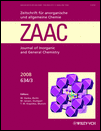Homologous Silver Bismuth Chalcogenide Halides (N, x)P. III. The (4, x)P, (5, x)P, and (7, x)P Structure Families of Modular Compounds with Tunable Composition and Structure
Abstract
The crystal structures of six members of the homologous series with general formula [BiQX]2[AgxBi1−xQ2−2xX2x−1]N+1 (Q = S, Se; X = Cl, Br; 1/2 ≤ x ≤ 1) and N = 4, 5, or 7 were determined by single-crystal X-ray diffraction. The series are characterized by the parameters N and x and are denoted (N, x)P. Ag3Bi4S6Cl3 (x = 0.60) (I), Ag3.5Bi3.5S5Br4 (x = 0.70) (II) and Ag3.65Bi3.35Se4.70Br4.30 (x = 0.73) (III) belong to (4, x)P series Ag5xBi7−5xQ12−10xX10x−3 and adopt the AgBi6S9 structure type. The (5, x)P compound Ag3.66Bi4.34S6.68Br3.32 (IV), which corresponds to x = 0.61 in Ag6xBi8−6xS14−12xBr12x−4, crystallizes isostructurally to AgBi3S5. The compounds Ag4.56Bi5.44Se8.88Br3.12 (x = 0.57) (V) and Ag5.14Bi4.86S7.76Br4.24 (x = 0.64) (VI), which are members of (7, x)P series Ag8xBi10−8xQ18−16xBr16x−6, adopt the Ag3Bi7S12 structure type. In the monoclinic crystal structures (space group C2/m) two kinds of layered modules alternate along [001]. Modules of type A uniformly consist of paired rods of face-sharing monocapped trigonal prisms around Bi atoms with octahedra around mixed occupied metal positions (M = Ag/Bi) between them. Modules of type B are composed of [MZ6] octahedra, which are arranged in NaCl-type fragments of thickness N. All structures exhibit Ag/Bi disorder in octahedrally coordinated metal positions as well as Q/X mixed occupation of some anion positions. Corresponding to their black color, all compounds are narrow-gap semiconductors (Eg = 0.35 eV for (II)). General characteristics of the entire class of (N, x)P compounds are gathered in a catalogue.




